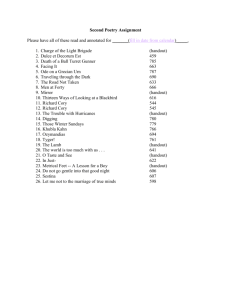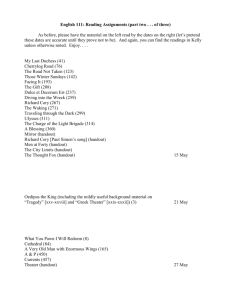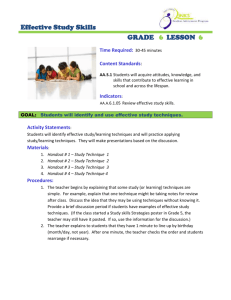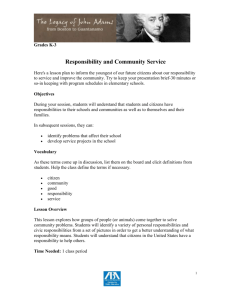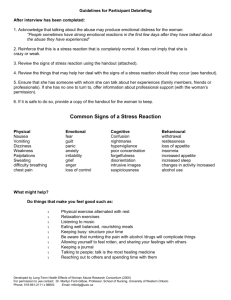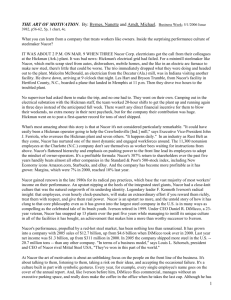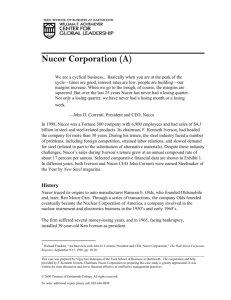In the Airbus-Boeing-McDonald-Douglas case ,we will
advertisement
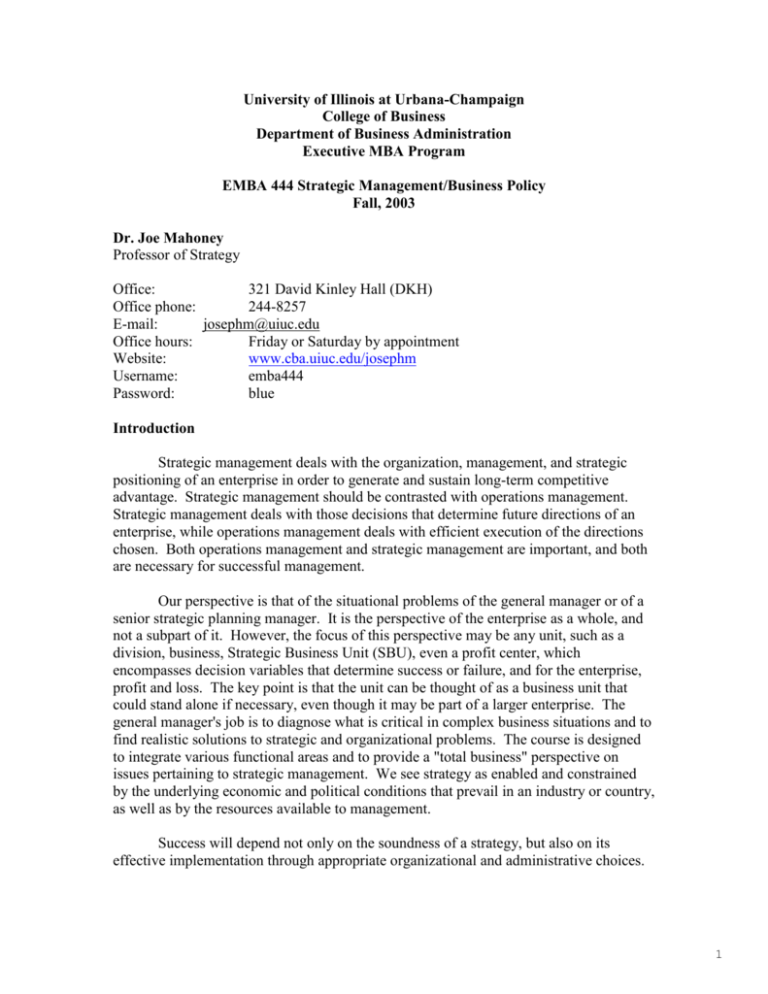
University of Illinois at Urbana-Champaign College of Business Department of Business Administration Executive MBA Program EMBA 444 Strategic Management/Business Policy Fall, 2003 Dr. Joe Mahoney Professor of Strategy Office: 321 David Kinley Hall (DKH) Office phone: 244-8257 E-mail: josephm@uiuc.edu Office hours: Friday or Saturday by appointment Website: www.cba.uiuc.edu/josephm Username: emba444 Password: blue Introduction Strategic management deals with the organization, management, and strategic positioning of an enterprise in order to generate and sustain long-term competitive advantage. Strategic management should be contrasted with operations management. Strategic management deals with those decisions that determine future directions of an enterprise, while operations management deals with efficient execution of the directions chosen. Both operations management and strategic management are important, and both are necessary for successful management. Our perspective is that of the situational problems of the general manager or of a senior strategic planning manager. It is the perspective of the enterprise as a whole, and not a subpart of it. However, the focus of this perspective may be any unit, such as a division, business, Strategic Business Unit (SBU), even a profit center, which encompasses decision variables that determine success or failure, and for the enterprise, profit and loss. The key point is that the unit can be thought of as a business unit that could stand alone if necessary, even though it may be part of a larger enterprise. The general manager's job is to diagnose what is critical in complex business situations and to find realistic solutions to strategic and organizational problems. The course is designed to integrate various functional areas and to provide a "total business" perspective on issues pertaining to strategic management. We see strategy as enabled and constrained by the underlying economic and political conditions that prevail in an industry or country, as well as by the resources available to management. Success will depend not only on the soundness of a strategy, but also on its effective implementation through appropriate organizational and administrative choices. 1 Our concerns are strategic decisions, and with both the content of those decisions and the processes by which general managers position the businesses and allocate resources in the face of both uncertainty and competition. We will be interested in tools and concepts that enhance our ability to define and analyze strategic problems and the alternative solutions of these strategic problems. Strategic problems are of two general types: (1) strategy formulation and (2) strategy implementation. Both types of strategic problems often occur within a complex organization coping with a dynamic and complex environment. This course focuses on key issues in formulating and implementing strategies to create and maintain a sustainable competitive advantage. The emphasis is on pragmatic and action-oriented general management skills. However, a considerable body of theory has evolved within the disciplines of strategy, economics, finance, marketing, organization theory, and international business that have salient implications for general management. Therefore, the course will emphasize both cases and lecture/discussion sessions. What is Strategy? Strategy: “The determination of the long-run goals and objectives of an enterprise, and the adoption of courses of action and the allocation of resources necessary for carrying out these goals.” Alfred D. Chandler Strategy and Structure Strategy: “The pattern or plan that integrates an organization’s major goals, policies, and action sequences into a cohesive whole. A well-formulated strategy helps to marshal and allocate an organization’s resources into a unique and viable posture based on its relative internal competencies and shortcomings, anticipated changes in the environment, and contingent moves by intelligent opponents.” James B. Quinn Logical Incrementalism Strategy: “Competitive strategy is about being different [i.e., strategic positioning]. It means deliberately choosing a different set of activities to deliver a unique mix of value. ... But a strategic position is not sustainable unless there are trade-offs with other positions. ... Tradeoffs create the need for choice and protect against repositioners and straddlers. ... Strategy is about combining activities [that are complementary and reinforcing]. ...[Strategic coherence] among many activities is fundamental not only to competitive advantage but also to the sustainability of that advantage. It is harder for a rival to match an array of interlocked activities than it is merely to imitate a particular sales-force approach, match a process technology, or replicate a set of product features. Positions built on systems of activities are far more sustainable than those built on individual activities.” Michael Porter “What is Strategy?” 2 CASE ANALYSIS An important component of the course is case analysis. A case is designed to provide you with data on real-life managerial problems, and case analysis is very useful as a simulation of actual managerial activity. The success of the case method, however, depends on your preparation and active participation. Objectives of Case Analysis: [1] Increase your understanding of what managers should and should not do in guiding business to success. [2] Build your skills in conducting strategic analysis and gain in-depth experience in a variety of industries, competitive situations, and company circumstances. [3] Get valuable practice in diagnosing strategic issues, evaluating strategic alternatives, and formulating workable plans of action. [4] Enhance your sense of business judgment. COURSE ORGANIZATION Your class assignments are shown in the syllabus attached, and while subject to change, this syllabus should guide your work planning for the course. There will be no announcements in class concerning assignments, except those infrequent ones that may alter those in the attached syllabus. TEACHING MATERIALS TEXTS Grant, Robert (2002). Contemporary Strategy Analysis: Concepts, Techniques, Applications. Malden, MA: Blackwell Publishers. CASES: Case #1 Case #2 Case #3 Case #4 Case #5 Presenting Group Wal-mart Stores Inc. RTE Cereal Cola Industry Saturn Module II Nucor Chicago Group Champaign 1 Group Bloomington Group Champaign 2 Group Peoria/Springfield 3 COURSE POLICIES Course Etiquette: 1. Be on time. Class begins at 8:30AM sharp. After a coffee break, the class begins again at precisely 10:30AM. 2. Do not disrupt the class with side conversations during class. 3. Be respectful of others in the class. Listen, give attention, let other people talk, don’t shout, and above all else do not sneer at others. 4. All cell phones and pagers should be turned off during class. Please do not leave and re-enter the class. 5. Using laptops in the classroom is a privilege, not a right. Laptops are to be used for class activities only. If you are seen net surfing or e-mailing during a class session you lose laptop privileges for the remainder of the EMBA 444 course. Course grade. Your class grade is a function of these elements: Element I. II. III. IV. V. VI. VII. Three Individual Assignments (10 points each) 30 points Saturn Cash Flow Group Assignment 30 points Nucor Cash Flow Group Assignment 30 points Present for at least 5 of the 7 sessions 50 points Or, you can write a ten-page paper. Class Participation (Beyond Showing Up) 50 points Group Presentation 60 points In-class exam (closed books, closed notes) 150 points ------------400 points Scale: I. Grade Points 370-400 = 360-369 = 350-359 = 330-349 = 320-329 = 300-319 = 290-299 = 280-289 = 250-279 = Below 250 = (Three) Individual One-page Assignments. A AB+ B BC+ C CD F (30 points) 4 You are expected to do all three assignments based on the schedule shown on the attached syllabus. Assignments are due before class begins on the day of the case (so bring an extra copy for you to use). One purpose of the assignment is to enhance class discussion. There is no credit provided for late assignments. The assignment should be single-spaced, typed (with an 11-point font or larger). Please analyze the case and do not bring in outside material in your 1-page assignment. Criteria for the three 1-page assignments are: (1) Problem Statement: A short paragraph that states the question (in the form of a question). Explain briefly in this paragraph WHY this question is important. (2 points) (2) Analysis. In order to answer your question, you need to: Explain what variables are important for answering your question. Define each of these variables clearly. Explain the interrelationships among the variables. (E.g., higher advertising intensity (defined as advertising expenditures to sales) is predicted to lead to higher market share in the national brewing industry that is predicted to lead to economies of scale, which is predicted to lead to lower costs and a source of competitive advantage.) In other words, make your chain of reasoning explicit to the reader. (5 points) USE DATA IN THE CASE TO SUPPORT YOUR IDEAS!! (3) Recommendation(s). II. You should make specific recommendations of courses of action. These recommendations must follow logically from the analysis! It helps if you explain why they follow from the analysis. As a final “reality check,” the suggested recommendations should be answers to the question raised in your first paragraph. (3 points) Saturn Group Assignment. (30 points) 5 A template will be provided for this assignment, based on the numbers provided in the case. You should provide: (a) (b) (c) III. Cashflow Analysis Scenario Analysis (changes within the model) Strategic Analysis (changes outside the model) Nucor Group Assignment. (10 points) (10 points) (10 points) (30 points) A template will be provided for this assignment, based on the numbers provided in the case. You should provide: (a) (b) (c) Cashflow Analysis Scenario Analysis (changes within the model) Strategic Analysis (changes outside the model) (10 points) (10 points) (10 points) IV. Attending at least 5 of the 7 sessions Or writing a 10-page paper (50 points) V. (Meaningful) Class Participation. (50 points) Active participation in the class is an essential part of the learning experience. We will be using cases and you must be prepared to discuss these cases. Meaningful participation means making a contribution to our discussion, not merely talking, and it does not mean repeating case facts or simply agreeing with what others have already said. Our interest is not "right" or "wrong,” it is whether you have made a contribution to the development of the issues under study by the class, and whether you have moved the class forward. One clear way of making a contribution is to disagree with the comments of your classmates where needed; it is not the instructor's duty alone to decide whether a remark is of value. Failure to participate and disagree where needed penalizes you and the class in these ways: VI. You lose incentive to prepare the case properly. You lose the chance to develop communication skills. You deprive all of us from your insights into the case. Your ideas go unevaluated by others. Group Presentation. In the first half of the class, the instructor will discuss the case. In the second half of the class the assigned group will update the case and provide strategic analysis. 6 Presentation Evaluation: (60 points) - Substance of Presentation (25 points) - Clarity: Audibility, wording, flow of ideas - Persuasiveness: Credibility, eye contact (05 points) - Use of visual aids: Clarity and readability (05 points) - Information clearly organized (05 points) - Management of time VII. (05 points) (05 points) - Equal division of time (05 points) - Ability to think on feet (05 points) Final Exam. (150 points) This exam will be an in-class, closed books exam. Please be aware that the final exam measures different skills than case analysis. The exam will test your understanding of the material provided. 7 COURSE SCHEDULE SESSION #1 Topic: Friday, September 5 (Morning Session in Champaign) The Role of Strategic Management What is Performance? Learning Objectives: What is the hierarchy of strategies? What is the strategy framework? What are the conceptual approaches to defining performance? Pre-class Assignment: Read: Grant (2002) Chapters 1 and 2 Handouts: Handout #1 Handout #2 Handout #3 Handout #4 Handout #5 Website of Companies Management Skills Levels of Strategy Strategic Coherence Measurement of Firm Performance SESSION #2 Saturday, September 6 (Morning Session in Champaign) Topic: Industry Analysis Learning Objectives: What is the Structure-Conduct-Performance Model? What is Porter’s 5-Forces Model? How are the two models (above) related? Pre-class Assignment: Read: Grant (2002) Chapter 3 Handouts: Handout #6 A Note on Industry Analysis 8 SESSION #3 Saturday, September 13 (Morning Session in Chicago) First Half: Topic: Industry Analysis Learning Objectives: How does one test the S-C-P model? Pre-class Assignment: Read: Grant (2002) Chapter 4 Handouts: Handout #7 Empirical Testing of StructureConduct-Performance Second Half: Topic: Wal-mart Stores Inc. Learning Objectives: What are the sources of Wal-mart’s competitive advantage in discount retailing? How sustainable is Wal-mart’s competitive advantage? Quantifying Wal-mart’s competitive advantage Are supercenters the answer to the threats that Walmart faces? Pre-class Assignment: Read: Wal-mart Case Write: A one-page case write-up Primary Discussion Responsibility: SESSION #4 Chicago Friday, September 19 (Morning Session in Champaign) 9 First Half: Topic: Resources and Firm Capabilities Learning Objectives: How are resources and capabilities analyzed to identify the value potential of a business? Pre-class Assignment: Read: Grant (2002) Chapter 5 Handouts: Handout #8 Handout #9 Handout #10 Handout #11 Second Half: Strategic Groups Resources and Capabilities Learning Curves Basic Financial Model RTE CEREAL: One page-report Primary Discussion Responsibility: Champaign 1 ________________________________________________________________________ SESSION #5 Saturday, September 27 (Morning Session in Chicago) First Half: Topic: Commitment and Flexibility Learning Objectives: How does the sequencing of strategic moves affect outcomes? How can strategic commitment influence cooperative response? How can strategic commitment influence competitive response? Handouts: Handout #12 Handout #13 Handout #14 Handout #15 Valuing Strategic Flexibility Using Strategic Commitment to Influence Competitive Response Using Strategic Commitment to Influence Cooperative Response Strategic Management Notes Second Half: 10 Topic: Cola Wars Continue: Coke v. Pepsi in the 1990s Learning Objectives: How does one apply industry analysis? How can firms position their products? Using a 5-Forces analysis explain why concentrate producers have been so profitable. What are the current trends in the soft-drink industry? Pre-class Assignment: Primary Discussion Responsibility: SESSION #6 Read: Coke v. Pepsi Case (Case #3 in Ghemawat) Write: A one-page write-up Bloomington Saturday, September 27th (Afternoon Session in Chicago) First Half: We will analyze the Saturn case together. Second Half: Update of the Saturn Case Pre-class Assignment: Read: Saturn Case Write: Group Assignment Primary Discussion Responsibility: Champaign 2 11 SESSION #7 Friday, October 3 (Morning Session in Champaign) First Half: We will analyze the case together. Topic: Nucor Learning Objectives: What are the roles for organizational capabilities and organizational commitments? What is the role of managerial judgment in making major (sunk cost) commitments? Why has Nucor performed so well in the past? What are the industry effects? What are the firm-level capabilities? How sustainable an advantage might Nucor derive from thin-slab casting? Pre-class Assignment: Read: Nucor Case Write: Group Assignment Second Half: Update of the Nucor Case Primary Discussion Responsibility: Peoria/Springfield SESSION #8 Saturday, October 11 (Morning Session in Chicago) FINAL EXAM 12




